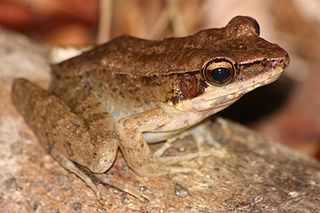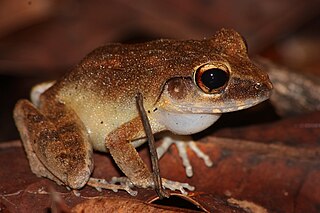
Papurana daemeli is a species of "true frog", family Ranidae. It is found in New Guinea, northern Australia, and some smaller islands. It is the only ranid frog found in Australia. In Australia, the species is restricted to the rainforest of northern Queensland and the eastern border of Arnhem Land, in the Northern Territory. In Australia, it is usually known as wood frog or sometimes as water frog. Other vernacular names are Australian wood frog, Australian bullfrog, and Arnhem rana.
Cornufer wolfi is a species of frog in the family Ceratobatrachidae. It is endemic to the Solomon Islands archipelago and known from the Buka and Bougainville Islands in Papua New Guinea and from the Santa Isabel and Choiseul Islands in the Solomon Islands. The specific name wolfi honours Eugen Wolf, a member of the Hanseatische Südsee-Expedition (1909) and writer of the expedition's travel report. Common name Wolf's sticky-toed frog has been coined for it.

Cornufer macrops, also known as the Aresi wrinkled gound frog, is a species of frog in the family Ceratobatrachidae. The specific name macrops refers to the very large eyes of this species. It is endemic to Bougainville Island, in the Papua New Guinean part of the Solomon Islands archipelago. It is only known from the mountains of northern Bougainville Island, near Kunua, although its true range could be much wider.
Cornufer macrosceles is a species of frog in the family Ceratobatrachidae. It is endemic to the island of New Britain, Papua New Guinea. It is only known from the Nakanai Mountains in the central part of the island. Only three specimens are known. Common name Ti wrinkled ground frog has been coined for the species.

Cornufer papuensis is a species of frog in the family Ceratobatrachidae. It is found in the northern parts of New Guinea and in many surrounding islands, including the Bismarck Archipelago, D'Entrecasteaux Islands, Trobriand Islands, and Maluku Islands including Sula Islands and Seram Island (Indonesia). Common name Papua wrinkled ground frog has been coined for the species.

The Amami tip-nosed frog is a species of frog in the family Ranidae. It is endemic to the Amami Islands, a part of the Ryukyu Islands, Japan. Specifically, it is known from the islands of Amamioshima and Tokunoshima.
Papurana garritor is a species of frog in the family Ranidae. It is endemic to New Guinea and widely distributed, found in both Indonesian and Papua New Guinean parts of the island. Common name Eilogo Estate frog has been coined for it.

The Albanian water frog is a species of true frog and is native to Albania and Montenegro. As its common name suggests, it prefers aquatic environments. The Albanian water frog is an endangered species and known populations are currently in decline. Significant threats to its habitat are presented by pollution and by drainage of wetlands, and a more direct threat is the aggressive collection of the species for commercial purposes.
Odorrana supranarina is a species of frog in the family Ranidae. It is endemic to Ryukyu Archipelago, Japan, and is known from the islands of Ishigaki and Iriomote, both in the Yaeyama Group. The specific name supranarina refers to the large size of this species —at the time of the species description, it was the largest member of the so-called Rana narina complex. Common name greater tip-nosed frog has been coined for it.
Chalcorana labialis, also known as the white-lipped frog, is a species of "true frog" in the family Ranidae. As currently known, it is endemic to Peninsular Malaysia, although it might also occur in Singapore. Molecular data suggest presence of three distinct lineages in the same area, one of which is not closely related to Chalcorana labialis and which could represent an unnamed species.

Hylarana, commonly known as golden-backed frogs, is a genus of true frogs found in tropical Asia. It was formerly considered highly diverse, containing around 84 to 96 valid species, but taxonomic revision resulted in a major change in the contents of the genus, and today it is recognised as containing just four species.

Papurana is a genus of frogs in the family Ranidae, "true frogs". They are known from New Guinea, some nearby islands, and northern Australia. Papurana daemeli is the only ranid frog found in Australia.
Papurana arfaki is a species of true frog, family Ranidae. It is widely distributed in New Guinea and also found on the Aru Islands (Indonesia). Common names Arfak Mountains frog and large river-frog have been coined for it. Its type locality is the Arfak Mountains.
Papurana aurata is a species of true frogs, the family Ranidae. It is only known from the area of its type locality near Nabire, in the Indonesian province of Papua, in New Guinea. The specific name aurata is Latin and refers to the gold-like colour of adult males.
Papurana grisea is a species of true frog. It is known with certainty only from its type locality in the Went Mountains, in the Indonesian province of Papua, New Guinea. Similar frogs are widespread in New Guinea, usually above 1,200 m (3,900 ft) above sea level, as well as on the Seram Island, but their identity is uncertain; they possibly represent another, undescribed species. Common names Went Mountains frog and Montaen swamp frog have been coined for it.

Papurana kreffti is a species of true frog, family Ranidae. It is native to New Ireland and Buka Island and the Solomon Islands. The specific name kreffti honours Gerard Krefft, a German adventurer who settled in Australia and became there to be regarded as the father of Australian herpetology. Common names San Cristoval frog and San Cristobal treefrog have been coined for it.
Papurana milneana is a species of "true frog", family Ranidae. It is endemic to Papua New Guinea where it is found in the upland areas of Milne Bay, Morobe, Northern, and Central Provinces, as well from the D'Entrecasteaux Islands and, tentatively, Louisiade Archipelago. It was originally described as a subspecies of Rana grisea, but raised to full-species status in 2007.

Papurana papua is a species of true frog, family Ranidae. It is endemic to New Guinea and found in the northern part of the island in both Indonesia and Papua New Guinea as well in some offshore islands. Common name Papua frog has been coined for it.
Papurana supragrisea is a species of true frog, family Ranidae. It is endemic to New Guinea, including some nearby islands. It is known with certainty only from southeastern New Guinea and from the D'Entrecasteaux Islands. However, this name has been used more broadly for a species complex that is widely distributed in the mountains of New Guinea. Common name Papua gray frog has been coined for it.

Papurana waliesa is a species of "true frogs", family Ranidae. It is endemic to Papua New Guinea where it is found in the southern Owen Stanley Range and the Pini Range in the eastern New Guinea as well as in the D'Entrecasteaux Islands. The specific name waliesa is derived from the Dobu word waliesa that means "namesake", in honor of Fred Malesa from Fergusson Island. He had greatly assisted the describers of this species during their expedition in the Milne Bay Province.









